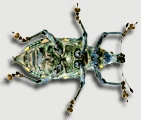Citation:
Abstract:
The Boston Harbor Islands Partnership (BHIP) and the Museum of Comparative Zoology (MCZ) at Harvard University collaborated to conduct the first phase of an All Taxa Biodiversity Inventory (ATBI) in Boston Harbor Islands national park area, Boston, Massachusetts. This six-year phase of the ATBI focused on the “microwilderness” of the park, a vast realm of invertebrate animals. The main objectives of this phase of the ATBI were threefold: (1) to document the diversity and distribution of arthropod and mollusk taxa in the park; (2) to engage and educate students and the public about local invertebrate biodiversity; (3) to use biodiversity data to inform park management. The project relied on the participation of more than fifty students, interns, citizen scientists, and volunteers to collect invertebrates on nineteen islands, and to sort, prepare, image, and database more than 75,000 specimens in the lab. Additionally, more than forty taxonomists from North America and Europe donated their time and expertise to identify 1,732 species and morphospecies. All specimens are permanently housed in the collections at the MCZ. Exploratory analyses of selected taxa suggested that, as predicted by the theory of island biogeography (MacArthur and Wilson 1967), island size was a reasonable predictor of species richness. However, an island’s distance from the mainland was correlated with species richness for only two of six taxa. Additional factors such as habitat diversity and habitat type (i.e., presence of freshwater or mature forests), as well as human-aided transport of species, appeared to be significant drivers of invertebrate distribution patterns across the islands. Numbers of introduced species were proportionally higher on the islands than on the coastal mainland for several beetle families, but comparable data for the mainland were lacking for most taxa, pointing to the lack of basic species distribution data that exist for invertebrates even in temperate, accessible locales. A large proportion of introduced species also had extremely high population counts and widespread distributions across islands, relative to native species.
Government Body:
National Park Service
